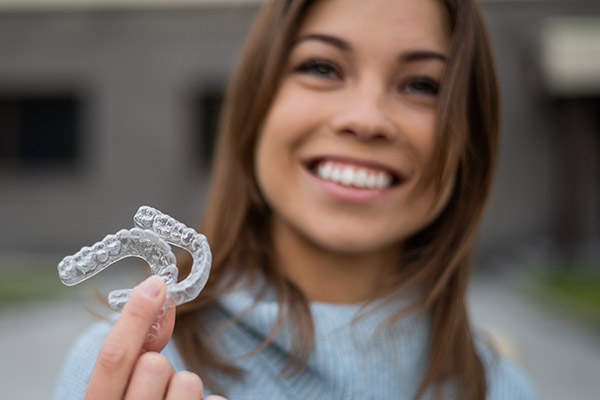Types of Retainers: Which One Is Best for You?

After achieving your desired smile alignment through braces or clear aligners, wearing a retainer can help protect your investment. Understanding the different types of retainers can help you choose the right one to suit your specific needs and lifestyle preferences. The following guide provides an overview of the most common types of retainers, their benefits, and potential drawbacks.
Choosing the right retainer
Choosing the most suitable retainer depends on a variety of factors. These include:
- Lifestyle
- Preferences
- Patience compliance
- Budget
- Orthodontic needs
Orthodontists typically provide personalized recommendations based on each patient's goals. Following professional advice and proper care routines can help ensure long-term results.
Types of retainers
Hawley retainers
While their use has faded in recent years, Hawley (wire) retainers are one of the most traditional types of retainers. These removable devices consist of a custom-molded plastic or acrylic base that rests on the roof of the mouth or along the lower jaw. Meanwhile, a metal wire runs across and around the front teeth, keeping them in place.
Hawley retainers offer several advantages. For one, they stay in place and are durable due to the use of sturdy materials. They are also removable, making them easy to adjust, clean, and maintain as needed. For patients looking to add some of their personality to their retainer, they can customize the colors or patterns of the plastic piece.
However, they also have drawbacks, such as the visibility of the metal wire, which may concern those looking for more discreet options. Some patients find them uncomfortable against their palate when adjusting to their retainer, causing a slight lisp.
Clear plastic retainers
Clear plastic retainers are popular for those who prefer a nearly invisible solution. Similar to clear aligner treatment, these retainers consist of transparent plastic molded to fit the exact shape of the patient's teeth. Many orthodontists recommend clear retainers as an effective way to keep patients' teeth in their desired position after finishing their orthodontic treatment.
Clear retainers are transparent, rendering them nearly invisible while also being lightweight and comfortable to wear at night, making it easier to ensure patient compliance. Unfortunately, this type of retainer is not as durable as others. This can lead to discoloration or odors if the patient does not clean them properly. Additionally, it is not possible to adjust clear plastic retainers.
Fixed retainers (permanent bonded retainers)
Fixed retainers, often referred to as permanent bonded retainers, consist of a thin metal wire bonded to the back of the teeth. They are typically used for the lower front teeth, although they can also be applied to upper teeth in some cases. Fixed retainers are not removable, but they are invisible, as they are bonded to the back of the patient's teeth. Many patients wear this type of retainer for months and sometimes years.
Fixed retainers are ideal for patients who do not want to worry about forgetting to wear their retain or losing it when not in use. They provide a consistent and effective treatment process. This is particularly true for those with a high risk of their teeth shifting to their pre-treatment position.
However, fixed retainers are harder to clean and require more effort to brush and floss compared to removable retainers. Although not visible from the front of the teeth, the tongue may still feel the wire, which some individuals find irritating and uncomfortable; dental wax can help with this. Over time, the bonding material may also wear down or break, requiring repair or replacement from an orthodontist.
Cleaning and maintaining retainers
Proper care can help maintain the longevity and effectiveness of retainers. Here are some general tips to ensure that one's retainer lasts as long as possible:
- Regular cleaning: Use a soft toothbrush and non-abrasive toothpaste to clean removable retainers daily. For fixed retainers, flossing tools such as floss threaders or water flossers can help maintain one's oral health in between dental appointments.
- Avoid exposure to heat: High temperatures can warp clear retainers. They should be kept away from hot water or direct sunlight.
- Safe storage: Always store removable retainers in their designated protective case when not in use to prevent loss or damage.
- Routine checkups: Regular visits to the orthodontist ensure that retainers remain in good condition and continue to fit properly.
Learn more about your retainer options
Retainers are an essential part of orthodontic treatment, ensuring that your newly aligned teeth remain in their corrected position. However, the choice between removable and fixed retainers will largely depend on your preferences and lifestyle. To learn more about your options, call our Reston office and schedule a consultation.
Request an appointment here: https://www.orthodonticprecision.com or call Precision Orthodontics & Pediatric Dentistry at (703) 391-8800 for an appointment in our Reston office.
Check out what others are saying about our services on Yelp: Read our Yelp reviews.
Recent Posts
Metal braces have been used to straighten teeth for over a century and remain an efficient way to straighten teeth. These oral appliances work by applying constant pressure on your teeth, slowly improving their alignment over 12 to 36 months. The appliance is fixed in your mouth after a dentist installs it, and it stays…
Like braces, clear aligner treatment can successfully straighten teeth and correct bite problems. Braces were the most popular and available choice for many years, but aligners are more common today than ever. If you are unhappy with the way your smile looks, aligners can be effective. Understanding how aligners work and what the process is…
As you prepare to get braces and start wearing them, you may be a little nervous. It can take some time to get used to this treatment. You will encounter some challenges, but the result can help you achieve your goals. During the process, you need to be diligent about caring for your braces. This…
A kids dental specialist is a type of dentist who focuses on seeing children and helping them with the needs unique to their developing dentition. Parents may wonder whether seeing a dentist specializing in kids is essential or if they can just see the same dentist the adults in the family trust.While a general dentist…


